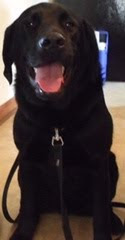Dray is training to find similar scents
in response to the command 'find another'
Since TMA is the only current body odor scent used to diagnose a body odor condition by scientists and medical professionals at this time, Dray is being trained to identify TMA, and to discretely alert to it even without being asked. But we all know that not all sufferers have a fish odor all of the time – not even those diagnosed with TMAU. So since we don’t know at this time how to reproduce all the odors we have in our community, we can ask Dray to help us begin a 'classification process' by grouping us into small groups based on the common scents of individuals by using the 'find another' command as demonstrated in this video.
Once Dray’s training is more advanced, we can begin using his conditioning to perform our own self-study. We can organize a meetup of volunteers who are willing to eat their respective odor-producing trigger foods prior to attending. Then, we can ask Dray to smell any one of us randomly, and then give him the command, “find another” to create a subgroup of those he identifies. Then, he would go on to another member of the group and perform the same command. This will help us see how many different scent groups he can detect out of our large group. We may not know which specific compounds he is detecting, but we will see whether he determines that we do indeed have different types of odor distinctive enough for him to distinguish from amongst them.
We thank Liz and Charlotte for having spent countless hours, days, weeks and months in the development of this TMAU Service Dog Program. AND WE'VE ONLY JUST BEGUN, THE SKY IS THE LIMIT!
Once our respective odors are grouped together by Dray and we are in the small groups 'Dray assigns', each group can take a group questionnaire/survey to compare symptoms and test results of each member (positive or negative for TMAU, Gut Dysbiosis Study results, other tests, digestive symptoms and diagnosed conditions, diagnosed allergies and sensitivities symptoms, autoimmune diseases, etc.) in order to find commonalities amongst each small group member to see if they differ from the other groups.
MeBO has approached various scientists who have wanted to help with research if we could only provide funding. One of the doctors was initially willing to write a grant proposal for us, but as we explored research options, it was determined that aside from TMAU, it became evident that basic data categorization of specific volatile odorous compounds have for specific body odor types has never been compiled in a scientific manner, and that categorization of the various body odor types is also nonexistent. In the absence of this data, there is no clear starting point or hypothesis with which to begin serious research.
This very valid reality was a clear indication that research would never take place and thus, we would never get answers to the causes of body odor conditions not only in non-TMAU sufferers, but also conditions TMAU sufferers may have in addition to their genetic disorder. This is where Dray and other TMAU Service Dogs can come in handy to help us begin with the very basic odor-type classifications, so that we can then study to see if any patterns emerge from the subjects in each odor-type classification. Hopefully, this data would then allow scientists to determine which hypothesis should be tested and what course of action to take.
This is only one idea for now to help us initiate an odor classification attempt that can hopefully be used for future studies and possibly research projects. I’m certain that we as a community can come up with many more uses of Dray's very sensitive olfactory system.
Charlotte, Dray's handler, has come up with a very good idea on how she would like to measure Drays ability to detect her own odor before humans begin detecting it. We shall see how that turns out after she and Dray give it a shot.
We thank Liz and Charlotte for having spent countless hours, days, weeks and months in the development of this TMAU Service Dog Program. To think, WE'VE ONLY JUST BEGUN; THE SKY IS THE LIMIT!
 Charlotte has not only adopted Dray, but has also spent a great deal of her time training him under Liz's direction, to be MeBO’s first TMAU Service Dog in an effort to help our community understand TMAU and other types of body odor conditions. Charlotte has frequently traveled a significant distance to Franfort, KY from her hometown for training lessons every week or every other week since our Nashville meetup in March 2010, incurring significant gas and hotel expenses, in addition to having committed to provide for Dray’s food and veterinary care for the rest of his life.
Charlotte has not only adopted Dray, but has also spent a great deal of her time training him under Liz's direction, to be MeBO’s first TMAU Service Dog in an effort to help our community understand TMAU and other types of body odor conditions. Charlotte has frequently traveled a significant distance to Franfort, KY from her hometown for training lessons every week or every other week since our Nashville meetup in March 2010, incurring significant gas and hotel expenses, in addition to having committed to provide for Dray’s food and veterinary care for the rest of his life.
If anyone would like to donate to this cause to help Liz and Charlotte with the expenses they incur for our TMAU Service Dog Program, you may use the Donate button to do so. You support is greatly appreciated.
 MeBO Research
MeBO Research
 María de la Torre
María de la Torre









